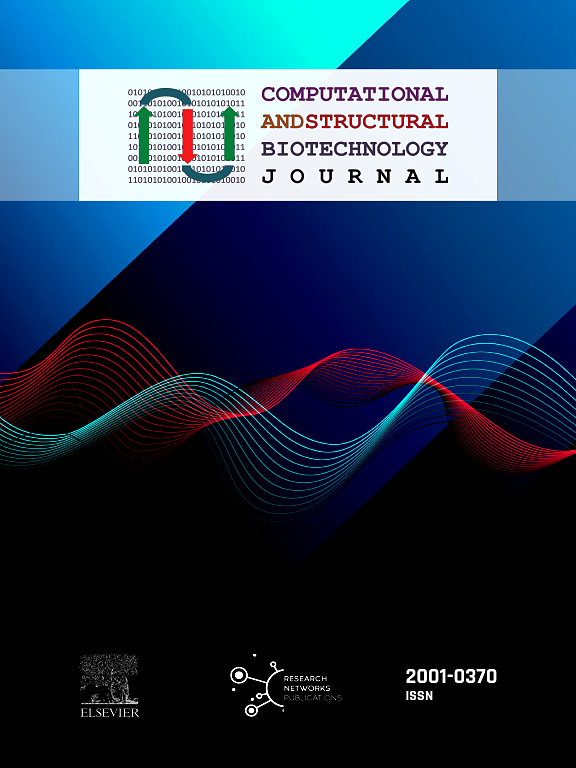对暴露于损伤性挑战的体外巨噬细胞进行的毒物基因组学评估揭示了持续的转录组免疫特征
IF 4.4
2区 生物学
Q2 BIOCHEMISTRY & MOLECULAR BIOLOGY
Computational and structural biotechnology journal
Pub Date : 2024-10-08
DOI:10.1016/j.csbj.2024.10.010
引用次数: 0
摘要
免疫信号是纤维化进程中的一个重要组成部分。然而,对潜在的促纤维化物质进行安全评估、提供机理免疫反应信息的方法还不完善。本研究旨在开发一种评估纤维化化合物免疫毒性的新框架。我们在体外将巨噬细胞暴露于多种亚致死浓度的促纤维化物质博莱霉素中,并在多个时间点进行检测,同时生成 RNA 测序数据。利用毒性基因组学方法,我们进行了剂量依赖性分析,以发现博莱霉素暴露以剂量反应方式导致的基因失调。免疫基因子集对损伤性挑战表现出持续的剂量依赖性和差异表达反应。免疫测定显示,细胞因子和蛋白酶对暴露于博莱霉素的反应与转录组的改变密切相关,这突显了转录免疫反应与外部免疫信号活动之间的整合。这项研究不仅加深了我们对纤维化免疫学机制的理解,还为对巨噬细胞信号具有潜在纤维化效应的物质进行毒理学评估提供了一个创新框架。我们的工作通过实施一种省时、省资源的体外方法,为纤维化化合物的危害评估提供了一个新的免疫毒性基因组学方向。本文章由计算机程序翻译,如有差异,请以英文原文为准。
Toxicogenomic assessment of in vitro macrophages exposed to profibrotic challenge reveals a sustained transcriptomic immune signature
Immune signalling is a crucial component in the progression of fibrosis. However, approaches for the safety assessment of potentially profibrotic substances, that provide information on mechanistic immune responses, are underdeveloped. This study aimed to develop a novel framework for assessing the immunotoxicity of fibrotic compounds. We exposed macrophages in vitro to multiple sublethal concentrations of the profibrotic agent bleomycin, over multiple timepoints, and generated RNA sequencing data. Using a toxicogenomic approach, we performed dose-dependent analysis to discover genes dysregulated by bleomycin exposure in a dose-responsive manner. A subset of immune genes displayed a sustained dose-dependent and differential expression response to profibrotic challenge. An immunoassay revealed cytokines and proteinases responding to bleomycin exposure that closely correlated to transcriptomic alterations, underscoring the integration between transcriptional immune response and external immune signalling activity. This study not only increases our understanding of the immunological mechanisms of fibrosis, but also offers an innovative framework for the toxicological evaluation of substances with potential fibrogenic effects on macrophage signalling. Our work brings a new immunotoxicogenomic direction for hazard assessment of fibrotic compounds, through the implementation of a time and resource efficient in vitro methodology.
求助全文
通过发布文献求助,成功后即可免费获取论文全文。
去求助
来源期刊

Computational and structural biotechnology journal
Biochemistry, Genetics and Molecular Biology-Biophysics
CiteScore
9.30
自引率
3.30%
发文量
540
审稿时长
6 weeks
期刊介绍:
Computational and Structural Biotechnology Journal (CSBJ) is an online gold open access journal publishing research articles and reviews after full peer review. All articles are published, without barriers to access, immediately upon acceptance. The journal places a strong emphasis on functional and mechanistic understanding of how molecular components in a biological process work together through the application of computational methods. Structural data may provide such insights, but they are not a pre-requisite for publication in the journal. Specific areas of interest include, but are not limited to:
Structure and function of proteins, nucleic acids and other macromolecules
Structure and function of multi-component complexes
Protein folding, processing and degradation
Enzymology
Computational and structural studies of plant systems
Microbial Informatics
Genomics
Proteomics
Metabolomics
Algorithms and Hypothesis in Bioinformatics
Mathematical and Theoretical Biology
Computational Chemistry and Drug Discovery
Microscopy and Molecular Imaging
Nanotechnology
Systems and Synthetic Biology
 求助内容:
求助内容: 应助结果提醒方式:
应助结果提醒方式:


